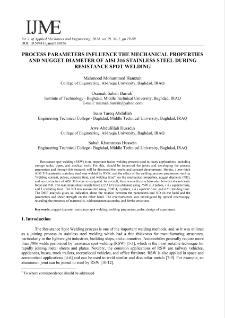Digital Library of Zielona Góra contains 65 391 digital objects
Object
Title: Process parameters influence the mechanical properties and nugget diameter of AISI 316 stainless steel during resistance spot welding
Creator:
Hamzah, Mahmood Mohammed ; Barrak, Osamah Sabah ; Abdullah, Isam Tareq ; Hussein, Sabah Khammass
Date:
Resource Type:
Contributor:
Group publication title:
Abstract:
Resistance spot welding (RSW) is an important fusion welding process used in many applications, including storage tanks, pipes, and medical tools. For this, should be improved the joints and developing the process parameters and through this research will be discussed the results and concept development. Herein, 1 mm-thick AISI 316 austenitic stainless steel was welded by RSW, and the effect of the welding process parameters, such as "welding current, pulses, squeeze time, and welding time", on the mechanical properties, nugget diameter (ND), and microstructure of AISI 316 were investigated. ; As a result, there was a direct relationship between shear-tensile force and ND. The maximum shear-tensile force (12.5 kN) was obtained using 7500 A, 3 pulses, 1.8 s squeeze time, and 1 s welding time. The ND was maximized using 7500 A, 3 pulses, 1.6 s squeeze time, and 0.8 s welding time. The DOE analysis gives an indication about the relation between the parameters and ND on the hand and the parameters and shear strength on the other hand. The microstructure was investigated by optical microscopy, revealing the presence of martensitic, widmanstatten austenite, and ferrite structures.
Publisher:
Zielona Góra: Uniwersytet Zielonogórski
Format:
Resource Identifier:
DOI:
Pages:
Source:
IJAME, volume 29, number 2 (2024)
Language:
License:
License CC BY-NC-ND 4.0:
Rights:
Biblioteka Uniwersytetu Zielonogórskiego
Object collections:
- Digital Library of Zielona Góra > Repository > Faculties > Faculty of Mechanical Engineering
- Digital Library of Zielona Góra > Repository > Types of work > Articles
- Digital Library of Zielona Góra > Repository > Scientific journals and UZ publishing series > International Journal of Applied Mechanics and Engineering (IJAME) > International Journal of Applied Mechanics and Engineering (IJAME) (2024)
Last modified:
Jul 15, 2024
In our library since:
Jul 15, 2024
Number of object content hits:
261
All available object's versions:
https://zbc.uz.zgora.pl/publication/89883
Show description in RDF format:
Show description in OAI-PMH format:
Objects Similar
Sar, Mohammed Helan Ridha, Munaf Hashim Barrak, Osamah Sabah Hussein, Sabah Khammass Jurczak, Paweł - red.
Ridha, Munaf Hashim Saad, Mursal Luaibi Abdullah, Isam Tareq Barrak, Osamah Sabah Hussein, Sabah Khammass Hussein, Abbas Khammas Jurczak, Paweł - red.
Ibrahim, H.K. Hussein, Sabah Khammass Jadee, Khudhayer Jurczak, Paweł - red.
Sarkar, Nantu Lahiri, Abhijit Jurczak, Paweł - red.
Boudjedra, Fatiha Benouis, Abdelhalim Boudaoud, Zineddine Kuczyński, Tadeusz - red.

